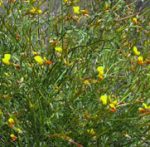 Also known as wiry lotus, broom bird’s-foot trefoil, and desert rockpea, this twiggy perennial is a subshrub native to southwestern US and Mexico from Utah and California, south to northwestern Mexico where it grows along roadsides, on dry slopes and plains, and in the Mohave and Sonora deserts. It is a member of the pea family, Fabaceae, that also includes lupine, mimosa, and black locust. Plants grow 1-3′ tall and have wiry upright stems covered with short bristly hairs. The gray-green egg-shaped leaves are sparsely distributed along the stems and are compound with 3-4 leaflets 2-6″ long. From late winter to spring 1-3 yellow pea-shaped flowers appear and slowly become tinted with red as they age. Each flower is 1/4- 3/4″ long and has a backward curving banner and 2 wing petals surrounding the 2 smaller keel petals. The green to reddish seed pods are slender with an up-slanted pointed tip. Plants are a food source for desert tortoises and the flowers attract hummingbirds and bees. Shrubby deervetch is a good choice for desert gardens and xerscapes. The genus name, Lotus, is the Greek and Latin name for a several plants including some that are not related to those in this genus. The specific epithet, rigidus, is the Latin word meaning stiff.
Also known as wiry lotus, broom bird’s-foot trefoil, and desert rockpea, this twiggy perennial is a subshrub native to southwestern US and Mexico from Utah and California, south to northwestern Mexico where it grows along roadsides, on dry slopes and plains, and in the Mohave and Sonora deserts. It is a member of the pea family, Fabaceae, that also includes lupine, mimosa, and black locust. Plants grow 1-3′ tall and have wiry upright stems covered with short bristly hairs. The gray-green egg-shaped leaves are sparsely distributed along the stems and are compound with 3-4 leaflets 2-6″ long. From late winter to spring 1-3 yellow pea-shaped flowers appear and slowly become tinted with red as they age. Each flower is 1/4- 3/4″ long and has a backward curving banner and 2 wing petals surrounding the 2 smaller keel petals. The green to reddish seed pods are slender with an up-slanted pointed tip. Plants are a food source for desert tortoises and the flowers attract hummingbirds and bees. Shrubby deervetch is a good choice for desert gardens and xerscapes. The genus name, Lotus, is the Greek and Latin name for a several plants including some that are not related to those in this genus. The specific epithet, rigidus, is the Latin word meaning stiff.
Type: Herbaceous perennial or subshrub
Bloom: one to three yellow pea-like flowers per stem in late winter to spring
Size: 1-3′ H 1-3′ W
Light:Full sun; tolerates some shade.
Soil: Average, dry, well-drained
Hardiness: Zones 7-10
Care: Prune to renew growth
Pests and Diseases: None of significance
Propagation: Seed
Companion Plants: Lupine, coreopsis, spurge, smooth ground cherry (Phasalis longifolia)